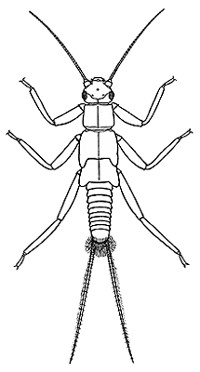

Tower and Town, August 2020 (view the full edition) (view the full edition)How Clean Is The Kennet?Anyone observing the crystal-clear water of the Kennet would presume that it is an extremely clean river. Rainwater seeps down through the chalk into deep aquifers before returning to the surface via springs such as Swallowhead, near Avebury. Sadly, even this source water is contaminated by nitrates and phosphates, the legacy of fertiliser use on the Downs. Further downstream, the river has to cope with a battery of pollutants such as run-off from roads, silt from ploughed fields and water coming out of the sewage treatment plants dealing with all sorts of waste from our homes.  Cased and Caseless Caddis Fly Larvae Cased and Caseless Caddis Fly LarvaeIn order to assess how clean the water really is, it is possible to carry out chemical tests but these are expensive and time-consuming. A much cheaper method is to take a sample of the creatures that live in the riverbed. The presence or absence of certain “indicator species” is used to determine the water quality. Coordinated by Action for the River Kennet (ARK), 62 sites in the Kennet catchment are monitored every month, the volunteers recording the numbers of freshwater shrimps, mayflies, caddisflies and stoneflies.  Stonefly Fly Larvae These invertebrates are very sensitive to pollution and, like canaries in coalmines, can be used as effective early indicators of pollution events. If invertebrate numbers drop below a certain level, the Environment Agency is notified so that the problem can be identified and action taken. In July 2013, ARK’s monitors were the first to discover a catastrophic pesticide pollution event which eradicated the invertebrates over a 15 km stretch of the river. So, how clean is the Kennet? Students from the University of Reading took water samples on 11th February 2020 at 8 sites from West Kennet to Reading. Only two sites had phosphate concentrations which would meet Good status as defined by the Water Framework Directive, whilst at every site nitrate levels were alarming, all falling into the categories of High and Very High levels of pollution defined by the Freshwater Habitats Trust.  Mayfly Fly Larvae In the first week of July, The Guardian, working with the Rivers Trust, revealed that through 2019 untreated sewage flowed into the Kennet catchment for more than 12,200 hours in 2,798 combined sewer overflow incidents. These discharges of untreated sewage are usually consented by the Environment Agency to allow treatment works to deal with unusually high flows, but it is seems incredible that they happen so frequently, and not always after heavy rain.  Freshwater Shrimp Seán Dempster |